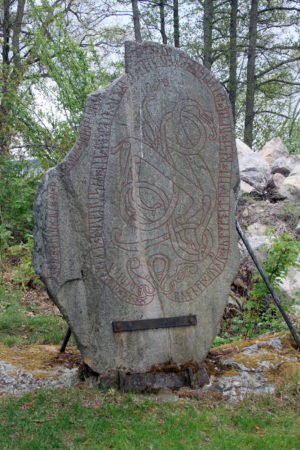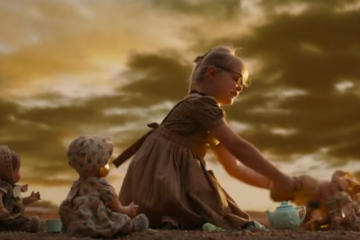Sweden: The Stone Ships and Goddess Cult of Västmanland
IN SWEDEN, while Uppland boat burials are all for men, in Tuna, Västmanland, the boat burials contain women. The only runestone dedicated to a woman, the Odendisa stone, is also in Västmanland. By the 1st century AD, the Nordic boat cult was expressed in this area in the form of ship-shaped stone circles known as “skeppssättningar” — there were five at Anundshög which is also the site of a huge Viking burial mound and a runestone with a unique picture which seems to suggest a fertility cult was there.
I visited all these on my trip to Västmanland. About the Odendisa stone, Wikipedia states:
The Odendisa Runestone, sometimes called the Hassmyra Runestone, is a Viking Age runestone erected at Hassmyra, Västmanland, Sweden, that is a memorial to a woman.
The runic text carved on the serpent of the Odendisa Runestone contains a poem in fornyrðislag and is one of few runestones raised for a woman, and the only one in Sweden with a verse commemorating a woman.[1]
KumbR hifrøya
til Hasvimyra
æigi bætri,
þan byi raðr.
There will come
to Hassmyra
no better wife,
who arranges the estate.
Note that she was the one “who arranges the estate.” This runic inscription is a reference to the centrality of women in early medieval Scandinavian (“Viking”) society where the woman was in charge of the estates and the homesteads and wore the keys of the buildings.
The theophoric name Odendisa (Old Norse: Óðindísa), which means “Goddess of Odin,” is a unique name and is not known from any other source. In addition, the name of her husband is very rare.

The Odendisa Runestone was carved by Red-Balli, a famous runemaster who was active in the region around lake Mälaren in the second half of the 11th century. The name Red-Balli is indicated by the runes roþbalir, which is not part of the main text carved on the serpent but starts a separate outer text band at the lower left of the inscription. This stone is classified as being carved in runestone style Pr4, also known as the Urnes style. This runestone style is characterized by slim and stylized animals that are interwoven into tight patterns. The animal heads are typically seen in profile with slender almond-shaped eyes and upwardly curled appendages on the noses and the necks.
In modern times, the stone is mentioned as early as the 1660s. According to tradition, a farmer discovered the runestone while he plowed the field. A few years later it cracked into two parts, but it was mended in 1900 and raised anew at its present location.
* * *
Source: Survive the Jive





